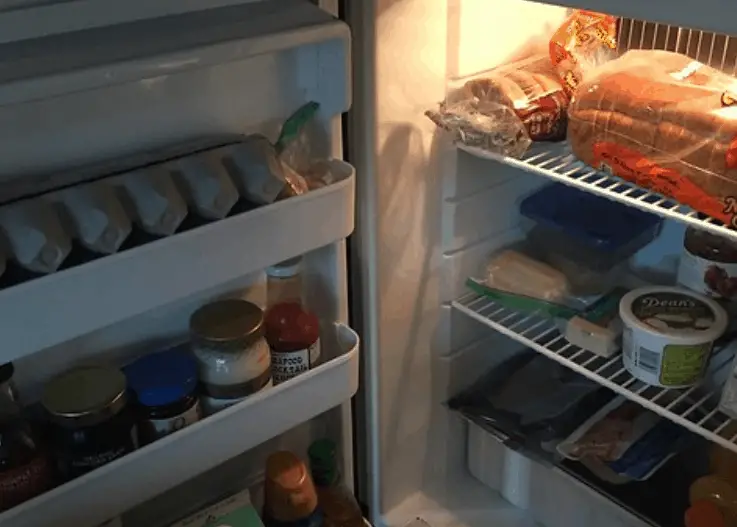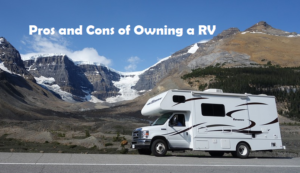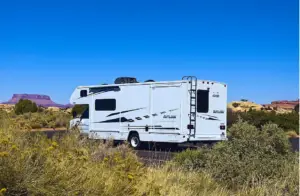Mold is nasty and it stinks! It’s born from carelessness and fueled by nature. It grows fast and it invades. When you discover it for the first time, it leaves a blank look on your face.
Mold has no regard for human life and must be stopped at all costs and before all is lost and never to return! Or you will just have to buy a new refrigerator for your recreational vehicle.
Its only a range of a few hundred to a hefty couple thousand dollars, depending on your style and needs, to get a new one. If the fridge broke down mechanically and is reasonably unrepairable, then yea, it may be time to get a new one.
But if you are considering to get a new one because of mold, then lets pause, recuperate and figure out how to defeat this level one boss.
This is what happens
It’s time to bring the RV out of retirement. You grab the keys, you walk over to your RV and you start her up. She seems to be running fine. You walk around your RV to do a quick look over on the outside and then you go inside the camper part of your RV for a quick look over.
You’re just doing this before you get down to business with the real maintenance checks. You look in the shower, the toilet, and the kitchen sink. Everything looks good so far. After your quick look around and your final maintenance checks, you gather all your supplies and things for your trip.
Blankets, reading material, survival kits, first aid kits, food, etc. You put everything in its respective place. You go to place food in the refrigerator and lo and behold, a fuzzy, fury blackish, greenish monstrosity is staring you dead in your face. Not to mention the pungent odor its giving off. Then you remember, you forgot to clean the fridge.
Well, here are some tips for those of you who want to prevent such a thing from delaying your journey:
1. Empty your Refrigerator
Mold on unused refrigerator is a thing of common. At the end of your trip, you should be mindful to empty your refrigerator of any of its contents. Food, drinks, any kind of packaged goods that required refrigeration. This step is especially important because additional items like food can add to the mold buildup and make it more of a daunting task to get rid of.
Emptying your fridge should be one of the first courses of action taken when prepping your RV for storage. If you know you tend to forget things, then leave a note for yourself or delegate the responsibility to someone in your camp.
Work together for the better! Continuing on, you should leave your refrigerator door open for a few minutes to allow for some moisture to dissipate. Do this while you tinker around with some other things.
2. Wipe Down Your Refrigerator
Return back to your refrigerator with a dry cloth or a roll of paper towels so that you can wipe down any remaining moisture from the inside of the fridge. First you should remove shelving and any drawers from the fridge.
After doing that, spray your fridge with a cleaning solution of your choice. Try not to use anything to strong as it could potentially remove some of the sealant and lacquer inside the fridge. A solution like Simple Green will do. After spraying and wiping down the interior of the fridge, do the same for the shelving and drawers.
Once everything is sprayed and cleaned, leave the fridge door open and the shelving and drawers out for a few minutes so that they can completely dry . Again, you can go mess around with other tasks while the stuff is drying.
Come back with equal parts warm water, not hot, but warm water and bleach. Make sure to wear protective gear (i.e. rubber gloves, a face mask, and some sort of eye protection) because when cleaning, you could be splashed. Repeat process with all refrigerator items and let dry when done cleaning.
(Note: when on your trip, you can place a small box of baking soda in your fridge to help keep some of the moisture down, just remove at the end of trip.)
3. Leave Your Fridge Door Cracked Open while In Storage
Replace the shelving and drawers of the fridge and close the door slightly, prop it open with something so as to leave a crack so that air can circulate in and out of the fridge keeping it dry.
4. Make use of Dehumidifier
Depending on where you live could also has an effect on the moisture content in your RVs refrigerator, let alone the RV itself. If you store your RV in an area that is normally hot and humid then you should consider buying a dehumidifier and placing it in the storage area or inside the RV itself.
Just placing it in a general area inside the storage space would be suffice. Heat and humidity to mold is like spinach to Popeye! The dehumidifier will regulate the amount of moisture that is in the air and since you leave the fridge and freezer door open, the moisture can build up there without one.
5. Ventilating The RV and The Storage Area
Ventilation is key. Suggest ventilating the storage area so that air can enter, circulate, and exit. Ventilating will tremendously reduce the amount of moisture build up in your RVs fridge and inside the RV itself.
Remember moisture is and can be thought of as water and we all know how water can find its way to and through any crack and crevice on any surface. So again, living in hotter or humid climates and storing your RV there invites the creation of mold. So not only ventilating the storage area but ventilate the RV also. This will double the chances of reducing mold buildup.
6. Consider Having A Pressurized Blower
Though it may seem tedious, but having some sort of pressurized blower or air compressor would be an extra help for you, as water can creep and seep into the corners and linings of your RVs fridge. After wiping down your fridge with the warm soapy water and the bleach and water solution, stay aware that there is only so much a dry cloth or paper towels can do.
Having a air compressor of some sort will allow you the ability to spray those hard to reach and dry areas that your dry cloth can not reach. Ultimately, blowing out small particles of water that is hard to see and reach increases the likelihood of mold prevention. An investment and an idea well worth its weight, as it can prevent a headache, un-needed elbow grease, and potentially the shelling out of hard earned money.
The above suggestions are just a few ideas and steps that can be utilized to prevent the build up of pesky, stinky, stubborn mold. A nightmare like no other.
Getting Rid of Mold in Refrigerator
While there are methods that can be used to prevent mold build up, what about if you find mold buildup in your RV refrigerator? Below are some ideas that can be used to get rid of the mold.
Spraying The Mold
Depending on how severe the buildup is, you could probably spray cleaning solution on it and let sit so that it will begin to eat the mold and loosen it up for a thorough wipe down. There are solutions on the market tailored specific for this purpose.
Some may say that commercial cleaners are to harsh on the surfaces, and a bit dangerous to work around as it can cause irritations of the skin, etc. But you could always dilute the concoctions with a bit of water.
Use your best discretion about choosing which commercial cleaners to use. Read the labels, ask an employee what they would suggest and go from there.
Soaking The Mold
Like previously stated, the severity of the mold situation depends on the action you need to take. This is recommended for both light and heavy cases of mold infestations. If you want to try your best in saving some money from buying another RV refrigerator then consider soaking your RV with a cleaner for a long period of time. However, this is more so for heavy cases of mold.
Remove the shelving and drawers and place in a large container of cleaning solution. Allow those parts to soak for an hour or more. If possible, remove the fridge and place carefully on its back side in a way you don’t damage the coils in the back.
Pour in a cleaning solution of your choice and fill the fridge. Also let sit for an hour or more. Once the solution has worked its magic tip your fridge over and clear out the liquids. You may see some mold particles exiting as well. This confirms that the solution has loosened up the mold.You can either get in there and clean by hand or you can clean with a pressure washer. I personally recommend a pressure washer.
Its strong enough to cut through stubborn areas in the fridge. It also quickens the process. Use with caution though, you don’t want to damage the appliance.
After the therapeutic hose down, check to see if any mold is still there, which at this point you will have to exercise your elbows. It shouldn’t be too much of a task though. Wipe down thoroughly and dry it out with compressed air.
Do the same for your refrigerator’s shelving and drawers. You may not have to pressure wash those, but in case you feel you should, then have at it.
Alternative Cleaners
You maybe a safety or health conscious person. Or just genuinely concerned with the harshness of commercial cleaner products. That is absolutely fine! Having that mindset will be beneficial to you and anyone else you have helping you fight the battle hardened mold force. Some ideas below:
Use vinegar
While it isn’t the most pleasing smell, it sure will get the job done. After cleaning with it you may need to follow up with some soap and water to combat the stench left behind. You may need to invest in large amounts depending on how bad the mold buildup is.
Use peroxide
This cheap and mighty remedy is a great tool to implement in your mold combat arsenal. You also may need to invest in large amounts- situation pending.Soap and water- you may have to let it sit for an extreme amount of time, give or take the severity of the situation.Baking Soda and water solution- also let soak for an extended amount of time before cleaning.
(Note: pay attention to make sure that after cleaning you thoroughly dry as some of these solutions contain water.)
These are a few “all natural” solutions recommended by some of the RV refrigerator warriors today.
Conclusion
Mold formation and buildup in an RV fridge is due to the lack of attention payed and poor maintenance and preparation. Becoming a warrior against mold is not an ideal situation, it’s not worth the risk of sickness, or harming anyone else cursed with the task, and is a feat seldom won.
The mold can be prevented by taking precautions of how the appliance and RV is stored and how it is cleaned before storage. As the owner and caretaker of your RV, it is solely your responsibility to be mindful of this, and to facilitate duties if you are not able to do so yourself. Besides, that’s what family and friends are for!
P.S. While in storage, it can be debatable whether or not the RVs refrigerator should be unplugged or not. Some say you should and others say leave it plugged in and on. Reasons for unplugging is that it can drain battery life, which is deemed unnecessary. Others, because of their personal situation, like living a great distance from the storage area, suggest leaving it on so that it is cold and ready for future use.
You Decide.





